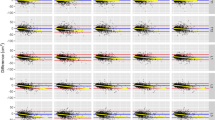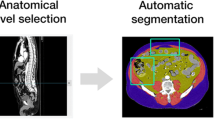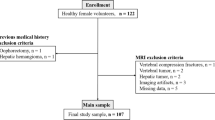Abstract
Purpose
Fully automated CT-based algorithms for quantifying bone, muscle, and fat have been validated for unenhanced abdominal scans. The purpose of this study was to determine and correct for the effect of intravenous (IV) contrast on these automated body composition measures.
Materials and methods
Initial study cohort consisted of 1211 healthy adults (mean age, 45.2 years; 733 women) undergoing abdominal CT for potential renal donation. Multiphasic CT protocol consisted of pre-contrast, arterial, and parenchymal phases. Fully automated CT-based algorithms for quantifying bone mineral density (BMD, L1 trabecular HU), muscle area and density (L3-level MA and M-HU), and fat (visceral/subcutaneous (V/S) fat ratio) were applied to pre-contrast and parenchymal phases. Effect of IV contrast upon these body composition measures was analyzed. Square of the Pearson correlation coefficient (r2) was generated for each comparison.
Results
Mean changes (± SD) in L1 BMD, L3-level MA and M-HU, and V/S fat ratio were 26.7 ± 27.2 HU, 2.9 ± 10.2 cm2, 18.8 ± 6.0 HU, − 0.1 ± 0.2, respectively. Good linear correlation between pre- and post-contrast values was observed for all automated measures: BMD (pre = 0.87 × post; r2 = 0.72), MA (pre = 0.98 × post; r2 = 0.92), M-HU (pre = 0.75 × post + 5.7; r2 = 0.75), and V/S (pre = 1.11 × post; r2 = 0.94); p < 0.001 for all r2 values. There were no significant trends according to patient age or gender that required further correction.
Conclusion
Fully automated quantitative tissue measures of bone, muscle, and fat at contrast-enhanced abdominal CT can be correlated with non-contrast equivalents using simple, linear relationships. These findings will facilitate evaluation of mixed CT cohorts involving larger patient populations and could greatly expand the potential for opportunistic screening.





Similar content being viewed by others
References
Pickhardt PJ, Graffy PM, Lubner MG, Summers RM. Opportunistic screening at abdominal CT using automated biomarkers: adding value beyond the clinical indication. RadioGraphics (submitted).
Graffy PM, Liu J, O'Connor S, Summers RM, Pickhardt PJ. Automated segmentation and quantification of aortic calcification at abdominal CT: application of a deep learning-based algorithm to a longitudinal screening cohort. Abdom Radiol 2019;44:2921–9.
Graffy PM, Liu J, Pickhardt PJ, Burns JE, Yao J, Summers RM. Deep learning-based muscle segmentation and quantification at abdominal CT: application to a longitudinal adult screening cohort for sarcopenia assessment. The British journal of radiology 2019:20190327.
Graffy PM, Sandfort V, Summers RM, Pickhardt PJ. Automated Liver Fat Quantification at Nonenhanced Abdominal CT for Population-based Steatosis Assessment. Radiology 2019:190512.
Lee SJ, Liu J, Yao J, Kanarek A, Summers RM, Pickhardt PJ. Fully automated segmentation and quantification of visceral and subcutaneous fat at abdominal CT: application to a longitudinal adult screening cohort. The British journal of radiology 2018;91:20170968.
Pickhardt PJ, Lee SJ, Liu JM, et al. Population-based opportunistic osteoporosis screening: Validation of a fully automated CT tool for assessing longitudinal BMD changes. The British journal of radiology 2019;92.
Pickhardt PJ, Graffy PM, Zea R, et al. Automated CT biomarkers for opportunistic prediction of future cardiovascular events and mortality in an asymptomatic screening population. Lancet Digit Health 2020.
Pickhardt PJ, Graffy PM, Zea R, et al. Opportunistic screening for metabolic syndrome in asymptomatic adults utilizing fully automated abdominal CT-based biomarkers. AJR American journal of roentgenology 2020 Jun 29 (Epub ahead of print).
Pickhardt PJ, Graffy PM, Zea R, et al. Automated abdominal CT biomarkers for opportunistic prediction of future major osteoporotic fractures in asymptomatic adults. Radiology 2020 Aug 11 (Epub ahead of print).
Boutin RD, Kaptuch JM, Bateni CP, Chalfant JS, Yao L. Influence of IV Contrast Administration on CT Measures of Muscle and Bone Attenuation: Implications for Sarcopenia and Osteoporosis Evaluation. Am J Roentgenol 2016;207:1046–54.
Pickhardt PJ, Lauder T, Pooler BD, et al. Effect of IV contrast on lumbar trabecular attenuation at routine abdominal CT: correlation with DXA and implications for opportunistic osteoporosis screening. Osteoporosis Int 2016;27:147–52.
Pompe E, Willemink MJ, Dijkhuis GR, Verhaar HJ, Mohamed Hoesein FA, de Jong PA. Intravenous contrast injection significantly affects bone mineral density measured on CT. European radiology 2015;25:283–9.
Burns JE, Yao J, Chalhoub D, Chen JJ, Summers RM. A Machine Learning Algorithm to Estimate Sarcopenia on Abdominal CT. Acad Radiol 2019.
Sandfort V, Yan K, Pickhardt PJ, Summers RM. Data augmentation using generative adversarial networks (CycleGAN) to improve generalizability in CT segmentation tasks. Sci Rep 2019;9:16884.
Summers RM, Baecher N, Yao JH, et al. Feasibility of Simultaneous Computed Tomographic Colonography and Fully Automated Bone Mineral Densitometry in a Single Examination. J Comput Assist Tomogr 2011;35:212–6.
Yao JH, Burns JE, Forsberg D, et al. A multi-center milestone study of clinical vertebral CT segmentation. Comput Med Imaging Graph 2016;49:16–28.
Yao JH, O'Connor SD, Summers RM. Automated spinal column extraction and partitioning. 3rd IEEE International Symposium on Biomedical Imaging: Macro to Nano, Vols 1–32006:390–3.
Acknowledgements
This research was supported in part by the Intramural Research Program of the National Institutes of Health Clinical Center, and utilized the high-performance computing capabilities of the NIH Biowulf cluster. We thank NVIDIA for GPU card donation.
Author information
Authors and Affiliations
Corresponding author
Ethics declarations
Conflict of interest
Dr. Pickhardt serves is an advisor to Bracco and Zebra and is a shareholder in SHINE, Elucent, and Cellectar; Dr. Summers receives royalties from iCAD, PingAn, Philips, ScanMed and Translation Holdings, and research support from PingAn (CRADA) and NVIDIA (GPU card donations).
Additional information
Publisher's Note
Springer Nature remains neutral with regard to jurisdictional claims in published maps and institutional affiliations.
Rights and permissions
About this article
Cite this article
Perez, A.A., Pickhardt, P.J., Elton, D.C. et al. Fully automated CT imaging biomarkers of bone, muscle, and fat: correcting for the effect of intravenous contrast. Abdom Radiol 46, 1229–1235 (2021). https://doi.org/10.1007/s00261-020-02755-5
Received:
Revised:
Accepted:
Published:
Issue Date:
DOI: https://doi.org/10.1007/s00261-020-02755-5




